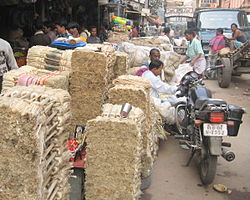Burra Bazar
| Burrabazar | |
|---|---|
| Neighbourhood in Kolkata (Calcutta) | |
| Barabazar | |

Maharshi Devendra Road
|
|
 |
|
| Coordinates: 22°34′55″N 88°21′07″E / 22.582°N 88.352°ECoordinates: 22°34′55″N 88°21′07″E / 22.582°N 88.352°E | |
| Country |
|
| State | West Bengal |
| City | Kolkata |
| Ward |
|
| Metro Station | Mahatma Gandhi Road |
| Parliamentary constituency | Kolkata Uttar |
| Assembly constituency | Jorasanko |
| Government | |
| • MLA | Samita Bakshi |
| Elevation | 11 m (36 ft) |
| Time zone | IST (UTC+5:30) |
| PIN | 700 007 |
| Area code(s) | +91 33 |
Burrabazar (also spelt Bara Bazar) is a neighbourhood in central Kolkata, earlier known as Calcutta, in the Indian state of West Bengal. It is an assembly constituency. Burrabazar expanded from a yarn and textile market into the commercial nucleus of Kolkata and the largest wholesale markets in India.
Burrabazar (Hindi: बडा बजार) is a Hindi word meaning big market. In Bengali, it is called Barobazar, (Bengali: বড় বাজার), the meaning remaining same. However, there is another theory. The neighbourhood was earlier named after ‘Buro’, the popular name of Shiva. The Hindi-speaking merchants who ousted the earlier local merchants, made it ‘Bara’.
Before the British came the most powerful families in the region were Sett and Bysacks, the merchants of yarn and cloth market at Sutanuti. With the arrival of the British these families flourished with renewed vigour. Janardan Sett was a trading agent of the British. Shobharam Bysack (1690–1773) became a millionaire by supplying textiles to British East India Company. One of the earliest names floating around is that of Mukundaram Sett, who lived in the earlier part of sixteenth century and moved from Satgaon to Gobindapur. Sutanuti haat has been traced back to 1738 by Orme. In the siege of 1756, troops of Siraj ud-Daulah set fire to the market and took possession of Jorabagan and Kumortuli, neighbourhoods further north where the merchants lived.
In between Sutanuti haat made way for Bazar Kolkata, some time in the 18th century. The market was spread over nearly 500 bighas and the residential area covered another 400 bighas. Apart from the Seths and Basaks, there were the gold merchants Mullicks and other men of their calibre. Their affluence and pomp are legends even in their days. There also were merchants of comparatively lesser affluence. As for example, the area around what is now Kalakar Street was known as Dhakapatty, as it was home to the Sahas, cloth merchants from Dhaka. The Sheths and Basaks had close links with such cloth producing centres as Dhaka, Murshidabad and Cossimbazar.
...
Wikipedia
